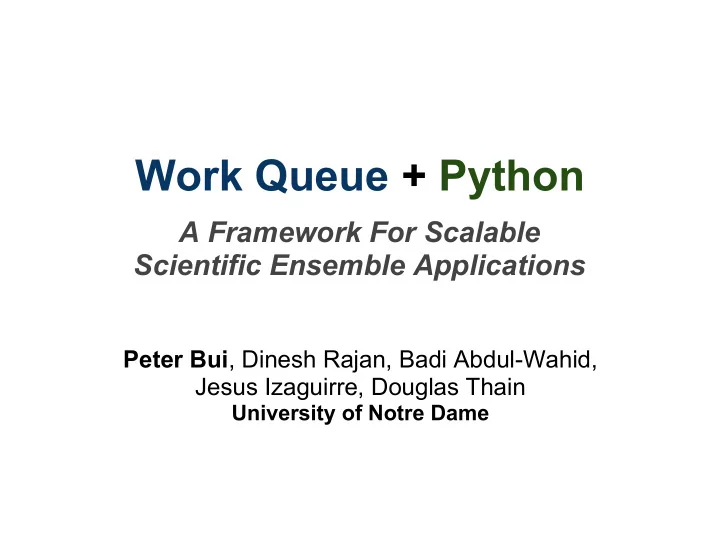

Work Queue + Python A Framework For Scalable Scientific Ensemble Applications Peter Bui , Dinesh Rajan, Badi Abdul-Wahid, Jesus Izaguirre, Douglas Thain University of Notre Dame
Distributed Computing Examples Examples ● Condor cluster ● SGE grid ● Beowulf cluster
Programming Challenges Resource Management ● Storage ● CPUs ● Network Scheduling ● Packaging ● Deployment ● Task dispatch Fault tolerance ● Nodes die ● Jobs fail ● Network problems
Work Queue A flexible master/worker framework for building large scale scientific ensemble applications that span many machines including clusters, grids, and clouds. Features ● Data management ● Fault tolerance ● Scheduling ● Fast abort ● Flexible worker deployment ● Catalog discovery service
Master/Worker Model Central Master Pool of Workers ● Divides work into tasks ● Receive input and ● Sends tasks to Workers executable files ● Execute task command ● Gathers results ● Return output files
Work Queue: Data Management, Fault Tolerance
Work Queue: Scheduling, Fast Abort Provides multiple algorithms for assigning tasks to workers: 1. First Come First Serve 2. Cached Files 3. Fastest Time 4. Preferred Hosts 5. Random To prevent stragglers, collect statistics, and perform fast abort on slow workers.
Work Queue: Worker Deployment, Architecture
Work Queue + Python ● Library is written in C and provides a straightforward API ○ C is a low-level language ○ Domain scientists familiar with scripting languages ● Provide Python bindings to library ○ Initially hand-written, but switched to SWIG ○ Allow scientists to high-level language ○ Access to large community and ecosystem of third-party software
Python-WorkQueue Module WorkQueue Task # Import work_queue module # Import work_queue module from work_queue import WorkQueue from work_queue import Task # Create master work queue # Create task wq = WorkQueue() task = Task('date > output.txt') # Set catalog project name # Specify output file wq.specify_name('project.name') task.specify_output_file('output.txt') # Set selection algorithm # Submit task to master wq.specify_algorithm( wq.submit(task) WORK_QUEUE_SCHEDULE_FILES) # Set fast abort factor wq.activate_fast_abort(1.5)
Example: Distributed Convert from workqueue import WorkQueue, Task import os, sys wq = WorkQueue() output_ext = sys.argv[1] # For each file, construct & submit a transcoding task for input_file in sys.argv[2:]: output_file = os.path.splitext(input_file)[0] + '.' + output_ext task = Task('convert %s %s' % (input_file, output_file)) task.specify_input_file(input_file) task.specify_output_file(output_file) wq.submit(task) # While workqueue is not empty, poll for task and then print command and result while not wq.empty(): task = wq.wait(1) if task: print task.command, task.result
Application: Replica Exchange
Evaluation: Replica Exchange Events A: Start 100 SGE workers B: Add 150 Condor workers C: Add 110 Condor and 40 Amazon EC2 workers D: Remove 100 SGE workers E: Remove 125 Condor and 25 Amazon EC2 workers
Application: Folding@Work
Evaluation: Folding@Work Results after One Month 283830 Tasks Assigned Results received 122141 Simulation time gathered 305 us Execution time average (min) 125 Execution time std. dev (min) 87 Number of workers 5000 Number of unique machines 370 Represents about 3,000 CPU days of work.
Future Work ● Use SWIG to generate bindings for additional languages (PERL, Lua, etc.) ● Monitoring and visualization software ● Extend Work Queue to better support hierarchical workflows ○ Multiple masters ○ Resource manage and allocation ● Integrate into Programming Paradigms course
Summary Work Queue is a flexible and powerful framework for constructing scalable scientific ensemble applications. ● Provides data management, fault-tolerance, multiple scheduling algorithms, fast abort, and support for multiple distributed systems. ● With Python-WorkQueue module it is now available in a user-friendly language.
Questions? CCTools Software Download http://cse.nd.edu/~ccl/software
Analysis ● Work Queue transparently handles worker additions and failures ● Work Queue harnesses resources from multiple distributed systems ● Work Queue scales to hundreds to thousands of workers
Work Queue: Success Stories Makeflow AllPairs SAND Wavefront
Work Queue versus MPI Work Queue MPI ● Orchestrates ensemble of ● Coordinates multiple multiple external executables instances of single ● Number of workers dynamic executable ● Scale up to large number of ● Number of workers static workers (10s, 100s, 1000s) ● Difficult to scale up to ● Reliable and fault tolerant limited number of workers at the task level (16, 32, 64) ● Allows for heterogeneous ● Reliable at application level deployment environments but no fault tolerance ● Workers communicate only ● Requires homogeneous with Master deployment environment ● Workers can communicate with anyone
Recommend
More recommend